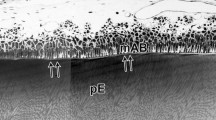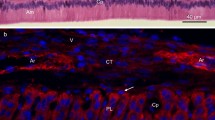Abstract
Ameloblasts are unique epithelial cells, in that once they have deposited the entire thickness of enamel and the process of maturation begins, they reform a basal lamina-like structure at their apical surface. In order to characterize further this basal lamina, its composition was analysed using (1) lectin-gold cytochemistry for glycoconjugates, (2) high-iron diamine (HID) staining for sulfated glycoconjugates and (3) immunogold labeling for collagen type IV and laminin. The labeling patterns were compared to that of other more “typical” basement membranes found in the enamel organ. Sections of rat incisor enamel organs embedded in Lowicryl K4M were stained with Helix pomatia agglutinin (HPA), Ricinus communis I agglutinin (RCA), wheat germ agglutinin (WGA) and Ulex europaeus I agglutinin (UEA). Samples from the late maturation stage were also reacted en bloc with lectins and embedded in Epon for transmission electron microscopic examination or prepared for scanning electron microscopy. Such samples were also stained with HID and conventionally processed for Epon embedding. Tissue sections were then reacted with thiocarbohydrazide-silver proteinate (TCH-SP). Analysis of the lectin labeling suggested that the region of extracellular matrix immediately adjacent to ameloblasts, where the basal lamina is situated, was intensely reactive with HPA and RCA, moderately reactive with WGA, and weakly reactive with UEA. In general, other basement membranes were mildly reactive with all lectins used. No HID-TCH-SP staining was observed directly over the basal lamina while numerous stain deposits were present over other basement membranes of the enamel organ. Immunolocalization of collagen type IV and laminin yielded a weak and variable labeling over the basal lamina. These results are consistent with the concept of basement membrane heterogeneity and, although the precise nature and composition of the basal lamina associated with maturation stage ameloblasts remain to be determined, they suggest that it may possibly function as a specialized basement membrane with particular compositional characteristics.
Similar content being viewed by others
References
Abrahamson DR (1986) Recent studies on the structure and the pathology of basement membranes. J Pathol 149:257–278
Akita H, Fukae M, Shimoda S, Aoba T (1992) Localization of glycosylated matrix proteins in secretory porcine enamel and their possible functional roles in enamel mineralization. Arch Oral Biol 37:953–962
Bendayan M (1984) Protein A-gold electron microscopic immunocytochemistry: methods, applications, and limitations. J Electron Microsc Techn 1:243–270
Bendayan M, Nanci A, Kan FWK (1987) Effect of tissue processing on colloidal gold cytochemistry. J Histochem Cytochem 35:983–996
Benhamou N (1989) Preparation and application of lectin-gold complexes. In: Hayat MA (ed) Colloidal gold: principles, methods, and applications, vol 1. Academic Press, San Diego, pp 95–143
Bosman FT, Cleutjens J, Beek C, Havenith M (1989) Basement membrane heterogeneity. Histochem J 21:629–633
Decker JD (1963) A light and electron microscope study of the rat molar enamel organ. Arch Oral Biol 8:301–310
Desjardins M, Bendayan M (1989) Heterogenous distribution of type IV collagen, entactin, heparan sulfate proteoglycan, and laminin among renal basement membranes as demonstrated by quantitative immunocytochemistry. J Histochem Cytochem 37:885–897
Desjardins M, Gras F, Wieslander J, Gubler M-C, Bendayan M (1990) Heterogeneous distribution of monomeric elements from the globular domain (NC1) of type IV collagen in renal basement membranes as revealed by high resolution quantitative immunocytochemistry. Lab Invest 63:637–646
Frank RM, Nalbandian J (1967) Ultrastructure of amelogenesis. In: Miles AEW (ed) Structural and chemical organization of teeth. Academic Press, New York, pp 399–466
Frens G (1973) Controlled nucleation for the regulation of particle size in monodispersed gold suspensions. Nature Phys Sci 241:20–22
Geoghegan WD, Ackerman GA (1977) Adsorption of horseradish peroxidase, ovomucoid and anti-immunoglobulin to colloidal gold for the indirect detection of concanavalin A, wheat germ agglutinin and goat anti-human immunoglobulin G on cell surfaces at the electron microscopic level: a new method, theory and application. J Histochem Cytochem 25:1187–1200
Hassell JR, Leyshon WC, Ledbetter SR, Tyree B, Suzuki S, Kato M, Kimata K, Kleinman HK (1985) Isolation of two forms of basement membrane proteoglycans. J Biol Chem 260:8098–8105
Hormia M, Virtanen I, Quaranta V (1992) Immunolocalization of integrin α6β4 in mouse junctional epithelium suggests an anchoring function to both the internal and external basal lamina. J Dent Res 71:1503–1508
Inage T, Shimokawa H, Teranishi Y, Iwase T, Toda Y, Moro I (1989) Immunocytochemical demonstration of amelogenins and enamelins secreted by ameloblasts during the secretory and maturation stages. Arch Histol Cytol 52:213–229
Kallenbach E (1970) Fine structure of rat incisor enamel organ during late pigmentation and regression stages. J Ultrastruct Res 30:38–63
Kallenbach E (1971) Electron microscopy of the differentiating rat incisor ameloblast. J Ultrastruct Res 35:508–531
Kallenbach E (1975) Fine structure of differentiating ameloblasts in the kitten. Am J Anat 145:283–318
Kanwar YS, Farquhar MG (1979) Presence of heparan sulfate in the glomerular basement membrane. Proc Natl Acad Sci USA 76:1303–1307
Kefalides NA, Alper R, Clark CC (1992) Biochemistry and metabolism of basement membranes. Int Rev Cytol 61:167–228
Kogaya Y, Kim S, Haruna S, Akisaka T (1990) Heterogeneity of distribution pattern at the electron microscopic level of heparan sulfate in various basement membranes. J Histochem Cytochem 38:1459–1467
Kurahashi Y, Moe H (1969) Electron microscopy of the ameloblasts in the later stage of the matrix formation stage and in the maturation stage of the enamel in rat. In: Araya S, Ijiri S, Kirino C, Mimura N, Suga S, Takuma S, Wada K (eds) Hard tissue research. Ishiyaku Shuppan, Tokyo, pp 254–285
Kurpakus MA, Stock EL, Jones JCR (1992) The role of the basement membrane in differential expression of keratin proteins in epithelial cells. Dev Biol 150:243–255
Laurie GW (1985) Lack of heparan sulfate proteoglycan in a discontinuous and irregular placental basement membrane. Dev Biol 108:299–309
Laurie GW, Leblond CP, Martin GR (1983) Light microscopic immunolocalization of type IV collagen, laminin, heparan sulfate proteoglycan, and fibronectin in the basement membranes of a variety of rat organs. Am J Anat 167:71–82
Leblond CP, Inoue S (1989) Structure, composition, and assembly of basement membrane. Am J Anat 185:367–390
Nanci A, Smith CE (1992) Development and calcification of enamel. In: Bonucci E (ed) Calcification in biological systems, CRC Press, Boca Raton, pp 313–343
Nanci A, Slavkin HC, Smith CE (1987a) Immunocytochemical and radioautographic evidence for secretion and intracellular degradation of enamel proteins by ameloblasts during the maturation stage of amelogenesis in rat incisors. Anat Rec 217:107–123
Nanci A, Zalzal S, Smith CE (1987b) Application of backscattered electron imaging and lectin-gold cytochemistry to visualize the distribution of glycoconjugates in a basal lamina. Scanning Microsc 1:1963–1970
Nanci A, Ahluwalia JP, Zalzal S, Smith CE (1989) Cytochemical and biochemical characterization of glycoproteins in forming and maturing enamel of the rat incisor. J Histochem Cytochem 37:1619–1633
Nanci A, McKee MD, Smith CE (1992) Immunolocalization of enamel proteins during amelogenesis in the cat. Anat Rec 233:335–349
Neiss WF (1984) Electron staining of the cell surface coat by osmium-low ferrocyanide. Histochemistry 80:231–242
Pannese E (1962) Observations on the ultrastructure of the enamel organ. III. Internal and external enamel epithelia. J Ultrastruct Res 6:186–204
Paulsson M (1992) Basement membrane proteins: structure, assembly, and cellular interactions. CRC Crit Rev Biochem Mol Biol 27:93–127
Rao CN, Goldstein IJ, Liotta LA (1983) Lectin-binding domains on laminin. Arch Biochem Biophys 227:118–124
Reith EJ (1967) The early stage of amelogenesis as observed in molar teeth of young rats. J Ultrastruct Res 17:503–526
Robinson C, Kirkham J (1985) Dynamics of amelogenesis as revealed by protein compositional studies. In: Butler WT (ed) The chemistry and biology of mineralized tissue. EBSCO Media, Birmingham, Alabama, pp 248–263
Roth J (1983) Application of lectin-gold complexes for electron microscopic localization of glycoconjugates on thin sections. J Histochem Cytochem 31:987–999
Ruch J-V (1987) Determinisms of odontogenesis. Cell Biol Rev 14:1–112
Sakai LY, Keene DR, Morris PN, Burgeson RE (1986) Type VII collagen is a major structural component of anchoring fibrils. J Cell Biol 103:1577–1586
Salonen J, Santti R (1985) Ultrastructural and immunohistochemical similarities in the attachment of human oral epithelium to the tooth in vivo and to an inert substrate in an explant culture. J Periodont Res 20:176–184
Sanes JR, Engvall E, Butkowski R, Hunter DD (1990) Molecular heterogeneity of basal laminae: isoforms of laminin and collagen IV at the neuromuscular junction and elsewhere. J Cell Biol 111:1685–1699
Sannes PL, Spicer SS, Katsuyama T (1979) Ultrastructural localization of sulfated complex carbohydrates with a modified iron diamine procedure. J Histochem Cytochem 27:1108–1111
Sawada T, Yamamoto T, Yanagisawa T, Takuma S, Hasegawa H, Watanabe K (1990a) Evidence for uptake of basement membrane by differentiating ameloblasts in the rat incisor enamel organ. J Dent Res 69:1508–1511
Sawada T, Yamamoto T Yanagisawa T, Takuma S, Hasegawa H, Watanabe K (1990b) Electron-immunocytochemistry of laminin and type-IV collagen in the junctional epithelium of rat molar gingiva. J Periodont Res 25:372–376
Sawada T, Yanagisawa T, Takuma S, Hasegawa H, Watanabe K (1992) Electron-immunocytochemical localization of laminin and type-IV collagen in the enamel organ of the rat incisor. Acta Histochem Cytochem 25:395–403
Schroeder HE, Listgarten MA (1977) Fine structure of the developing epithelial attachment of human teeth. In: Wolsky A (ed) Monographs in developmental biology, vol 2, 2nd edn. Karger, Basel
Silva DG, Kailis DG (1972) Ultrastructural studies on the cervical loop and the development of the amelo-dentinal junction in the cat. Arch Oral Biol 17:279–289
Slavkin HC, Bessem C, Bringas P Jr, Zeichner-David M, Nanci A, Snead ML (1988) Sequential expression and differential function of multiple enamel proteins during fetal, neonatal, and early postnatal stages of mouse molar organogenesis. Differentiation 37:26–39
Smith CE, Nanci A (1989) A method for sampling the stages of amelogenesis on mandibular rat incisors using the molars as a reference for dissection. Anat Rec 225:257–266
Smith CE, McKee MD, Nanci A (1987) Cyclic induction and rapid movement of sequential waves of new smooth-ended ameloblast modulation bands in rat incisors as visualized by polychrome fluorescent labeling and GBHA-staining of maturing enamel. Adv Dent Res 1:162–175
Smith CE, Pompura JR, Borenstein S, Fazel A, Nanci A (1989) Degradation and loss of matrix proteins from developing enamel. Anat Rec 224:292–316
Spicer SS, Hardin JH, Setser ME (1978) Ultrastructural visualization of sulphated complex carbohydrates in blood and epithelial cells with the high iron diamine procedure. Histochem J 10:435–452
Takano Y (1979) Cytochemical studies of ameloblasts and the surface layer of enamel of the rat incisor at the maturation stage. Arch Histol Jpn 42:11–32
Timpl R (1989) Structure and biological activity of basement membrane proteins. Eur J Biochem 180:487–502
Warshawsky H, Moore G (1967) A technique for the fixation and decalcification of rat incisors for electron microscopy. J Histochem Cytochem 15:542–549
Warshawsky H, Smith CE (1974) Morphological classification of rat incisor ameloblasts. Anat Rec 179:423–446
Author information
Authors and Affiliations
Rights and permissions
About this article
Cite this article
Nanci, A., Zalzal, S. & Kogaya, Y. Cytochemical characterization of basement membranes in the enamel organ of the rat incisor. Histochemistry 99, 321–331 (1993). https://doi.org/10.1007/BF00269105
Accepted:
Issue Date:
DOI: https://doi.org/10.1007/BF00269105




